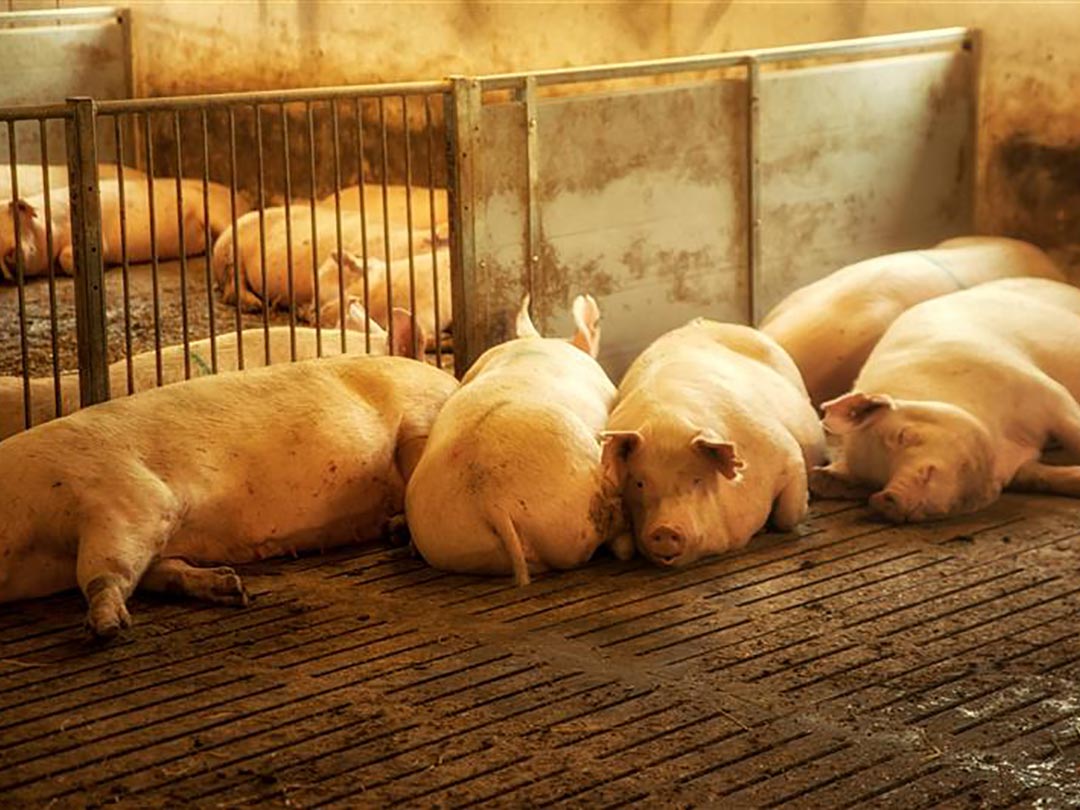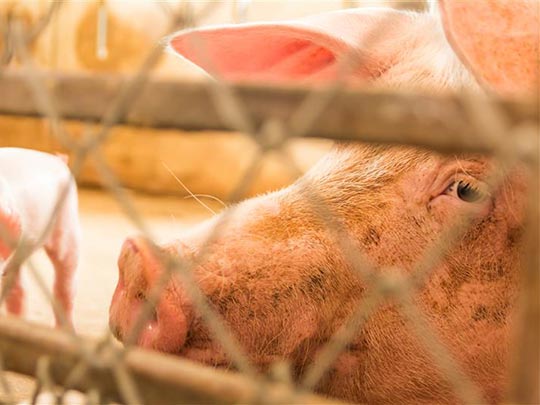Stress reduction in pig production
Not only we human beings face stressful situations. Pigs also suffer from stress – be it from heat, from feeding or handling. Thus, stress reduction in pig production is a topic of great interest. Learn in this article how phytogenics can contribute to relaxation for your pigs.

Animal welfare is a major concern of any intensive swine production as result of a growing conscience and respect for the animal as a living being - including the consumer, public opinion and even the pressure of legislation.
A key notion is needed:
“The welfare of an individual is its state as regards its attempts to cope with its environment. Welfare includes feelings and health and can be measured scientifically. It is a biological concept, quite different from rights, and refers only to living animals.“
Less stress for more success
Stress is associated with physio-pathological changes and strongly affects welfare and general productive parameters.
Several types of stress can occur – social, environmental, metabolic, immunological and stress due to human handling – with negative biological consequences for pigs.
Stress is perceived by the animals as a threat to their homeostasis and generates a variety of responses, including behavioral, neuroendocrine, and immunological.

It’s “fight or flight”
In the behavioral sciences, stress is “the perception of threat, with resulting anxiety, discomfort, emotional tension and difficulty in adjustments” (Fink, 2009).
As such, abnormal behavior is often an indicator of a response to stress factors. In neuroendocrinology, stress is a stimulus that provokes release of adrenocorticotropic hormone (ACTH) and adrenal glucocorticoids.
As a result of the body’s biological response to stress, various biomarkers can be used to evaluate and access the stress level in pigs.
An immediate response to a stress stimulus occurs in the adrenal medulla, via the activation of the sympathetic nervous system, and release of catecholamine hormones (epinephrine and norepinephrine). These hormones prepare the animal to face or escape the stress stimulus.
At the same time, the hypothalamus stimulates the release of the adrenocorticotropic hormone (ACTH), which promotes the production of glucocorticoids (such as cortisol). These are responsible for providing the necessary energy to “fight” stress, by the catabolism of protein and fat into glucose.
The neuroendocrine response to stress affects the animal’s immune system, which is activating in the case of a short-term stress stimulus and a suppressing in the case of a long-term stimulus.
Stressful stimuli and poor welfare…
… can have a negative impact on pig production parameters such as reproduction, behavior, immunity, performance and meat quality.
Thus, deleterious effects of stress were measured in growth rate and feed efficiency in growing and finishing pigs.
For example, it has been observed that a decrease in space availability per pig reduces the average daily gain by 15% and increases feed conversion ratio by 10% (Hyung et al., 1998). Environmental stress (e.g. high temperatures) resulted in a lower daily gain of 39% and a lower feed efficiency of 16% (White et al., 2008). But what measures can help for stress reduction in pig production?
Stress reduction in pig production with phytogenics
A study was performed by Delacon on growing and finishing pigs to evaluate the concentration of stress hormones (cortisol, epinephrine and norepinephrine) in blood under stress conditions (environmental stress – summer heat).
The control group received basal diets (a grower and a finisher diet) and the treated group received the same basal diets supplemented with Aromex® (100 g/Mt).
In this trial, the animals fed with the phytogenic feed additive showed lower epinephrine, norepinephrine and cortisol levels in blood serum, which underlies a positive effect of the phytogenic compounds in reducing the effect of stress in pigs.
You see: Phytogenics can be a helpful tool in stress reduction in pig production.
Sources:
Martínez-Miró et al. Causes, consequences and biomarkers of stress in swine: an update. BMC Veterinary Research (2016) 12:171
Gimsa U, Tuchscherer M and Kanitz E (2018) Psychosocial Stress and Immunity—What Can We Learn From Pig Studies? Front. Behav. Neurosci. 12:64.
Donald M. BROOM. Animal Welfare in the European Union. PE 583.114, European Union, 2017
Aromex® decreased stress hormones in blood serum of fattening pigs
| Cortisol (Ug/dL) | Norepinephrine (pg/mL) | Epinephrine (pg/mL) | |
| Control | 2.85 | 1068 | 153.8 |
| Aromex® | 1.99 | 1019 | 134.9 |
Diet: 2 Phases; Corn/SBM;
14.3 MJ ME; 18 and 16% CP, 9 and 8 g Lys/kg
Breed: (Yorkshire x Landrace) x Duroc
Body weight: 30-120 kg pigs
Gender: barrows and gilts
Housing: Group mixed gender
Total number of animals: 48
Replicates: 4 per treatment
Duration: 18 weeks
Treatments:
- Control
- Aromex® (100 g/MT)
Location: Dankook University, Korea
Blood samples were taken in 115 kg pigs in week 18 of trial

Sandra Chamusco
Global Technical Manager Swine at Delacon Sandra Chamusco has a degree in Animal Science at the University of Évora in Portugal and has been working in swine nutrition for more than 20 years. She was a feed formulator and customer consultant, technical responsible and Director of Operations at the Portuguese subsidiary of the French group CCPA. After that she was Director of Swine Nutrition Department at T.N.A. (Portugal). At Delacon,Sandra is responsible for product development and product support, and for the customer technical services for the complete range of Delacon’s swine products on a global level.










